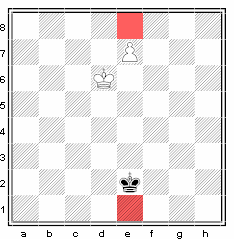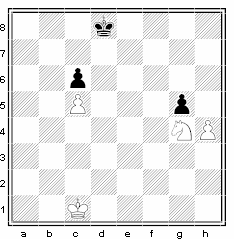Capture the Scepter
The idea behind this game was suggested by many before in several variants, but had not reached fruition because of fundamentally flawed assumptions that were made regarding the "drawing nature" of chess . Fortunately, this variant does not attempt to take away any aspect of standard chess that governs draws. Stalemate, 3-move repetition, perpetual check and 50 move draws are all as in orthodox chess.Capture the Scepter is essentially the orthodox game of chess played with the following two ideas:
The Scepter
This is a magic wand, possessed by both sides, which must be protected at all cost, for losing it to the opposing king loses the throne, the kingdom … everything. So in addition to checkmate - the surrender to the enemy - this is an additional objective in the game, but only a king can capture a scepter.The scepter is normally kept on the king's original square on e1 or e8. In some variations, Omega Chess, for instance, it can be kept on the king's wizard's square or in other variations, like Palace Ninja Guards, it might be kept on two squares. No matter how many squares it is kept on, the objective is for the king to capture the opposing king's scepter.
The scepter is never moved, and even if the king castles, the scepter remains on the same square.Stalemate where the opponent's king, even though surrounded, has tricked your forces and avoided checkmate
(visualize as a secret getaway or committing suicide), is still a draw.
A 3-time repetition of position that results from nether side unable to gain ground by engaging each other, is also a draw.
So, bearing this in mind not all games will end with a win or loss (though a much greater percentage will now).
For example, the white king can guard its own scepter and prevent the black king from getting it.
If black has no piece to attack the white king then it cannot pry it out, and the game will be drawn.

|
Outcome: Black or White win?
In this position even though white has succeeded in marching his pawn up the board, black has meanwhile marched his king up to the square to capture white's scepter! If it is white's turn to move, the pawn queens giving check with eventual checkmate to follow. OR the white king can then easily capture black's scepter at e8. If it is black turn to move, e2-e1 and white's scepter now belongs to black! So despite the white advantage Black still wins! |
The Extra-mobile sliding pawn
The second idea used regards the movement of the pawn. Normally, when a pawn faces an opposing pawn or an enemy piece, the pawn is blocked. However, the sliding pawn can, under these circumstances only if it is blocked, slide pass the enemy piece or pawn with the same 1-step diagonal movement that it would make when capturing.

|
Sliding Pawn movement
If it is white's turn to move: The pawn at c5 can slide past c6 by going to either d6 or b6. If it is black's turn to move, the pawn on c6 can slide to b5 or d5. Also the pawn at g5 can either capture the pawn at h4 (as usual) OR it can also slide past the white knight by moving to f4! |
Usage & Further Thoughts
The reader would have noticed that this variant has been presented more as a collection of ideas than as an actual variant. The reason being that while this is a perfectly valid variant of chess, there is no compelling reason why the orthodox game of chess needs to be played this way!For example, the Scepter rule will certainly reduce the percentage of draws (King and knight vs King is a draw), and introduce an interesting strategic component, but for the most part the game will end in checkmate for most players. (It is well known that high percentage of draws is only prevalent at very high levels of chess.)
The sliding pawns are even a tougher sell for there is nothing fundamentally wrong with the pawns in orthodox chess! (Contrary to what some erronoesly believe)
So what is the point of this variant?!It is established that the capture the scepter component is strategically rich and can be used, not just with orthodox chess, but also in other chess variants. Games like Flying Bombers Grand Chess, Asylum Chess and Omega chess can all employ this idea. In both Asylum Chess and in Flying Bombers Grand Chess, the scepter will be at f1 and f10, but in Omega Chess, the scepter will be at the king's wizard squares (this seems best). In Palace Ninja Guards, the scepter is at the squares: d9 or e9, and d0 or e0.
Similarly, the sliding pawns can be used as a feature in many different types of variants, especially variants that are not very chess-like i.e. dissimilar to standard chess. The author, being a bit cautious, will not suggest that the sliding pawns be used for chess-like variants like Flying Bombers Chess and Omega Chess simply because they change the nature of the game completely! However, other variant inventors are welcome to use the sliding pawns in their variants if they desire a more dynamic sort of pawn, just be warned, the effects of mobile pawns (and other types of unblocking pawns in other variants) have not been investigated thoroughly.
In the meantime why not play a totally different game of chess with mobile pawns and the kings’ scepters - Capture the Scepter!Update on this game!
Chess players who use chess.com will be very familiar with the variant: King of the Hill that has become quite popular. This variant is closely related to Capture the Scepter with the exception that the squares used are the 4 central squares.See chess.com for more info on this game!View other variants on chess.com
|
If you would like to email the chess variant inventor directly: inventor@chess.computerwebservices.net
|
|
Posted by: Jon Jacobs on 2007-10-24 17:20:25 Like Chess: YES
Well, I don't complain when someone advocating a variant is content to label it a variant rather than an "improved" form of real chess (that was my beef with Clint Ballard of BAP fame). And although I'm not usually inclined to give opinions on variants (by the way I view 960 not as a variant, but as real chess played from a different starting position), I will say this to justify my earlier claim that your variant removes many interesting strategic elements - probably more than it adds. Among the interesting strategic elements effectively eliminated by a "capture the scepter" rule: 1. Most material sacrifices that don't lead to a forced mate. Since the side with less material can almost never simplify into a drawn ending as in normal chess (see point #4 below), the risk/reward ratio for sacrificing material (even a pawn!) for position would swing dramatically against. That would all but eliminate what is perhaps the single most aesthetically appealing strategy in chess as we know it. 2. Outside pawns gain in value vs. central pawns. Although an outside passed pawn is a significant endgame trump even in regular chess, your "capture the scepter" rule would magnify that difference in value (again, see #4 below), to the point where preserving wing pawns might become an important consideration even in the opening. That would totally alter the strategy of controlling the center (which in normal chess makes central pawns more valuable than wing pawns in the opening and middlegame). 3. The value of the "two bishops" would for most intents and purposes cease to exist. That's because due to the "scepter" rule, one color bishop would have greater value (to each side) than the other. The QB (i.e., the one that controls one's own king's initial or "scepter" square) would have great defensive significance in endgames, since it can protect against loss from afar, thereby letting one side's king penetrate the enemy position without fear that the opposing king would conquer the scepter square. 4. Simplifying to a drawn ending. This means not only K+minor vs K (which you mentioned), but nearly all K+P vs K endings would be wins for the superior side as well, assuming the weaker side's K wasn't on the verge of occuping its opposite number's starting square. Specifically, a K+RP, NP or QBP would always win from any position (again, except those in which the weaker side's K already has a clear path to the winning square). K+f-pawn, e-pawn or d-pawn is a draw if the pawn is on its 6th rank and inferior side's K controls queening square and has the opposition (same as in normal chess). Without looking at a board, in my head I haven't worked out whether a pawn on those 3 middle files starting from 5th rank or less is a win or a draw. These 4 strategic casualties are just for starters. |

